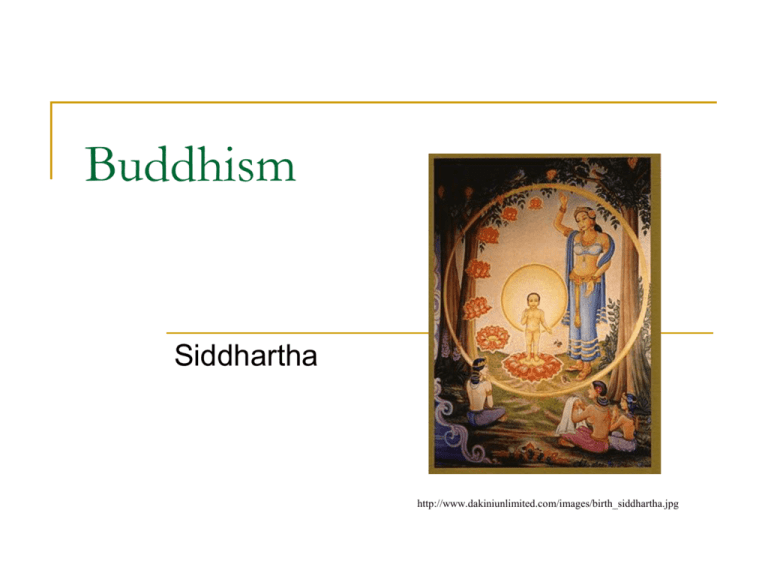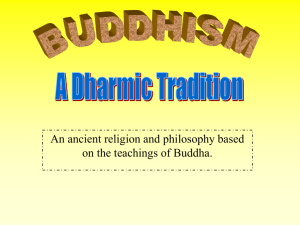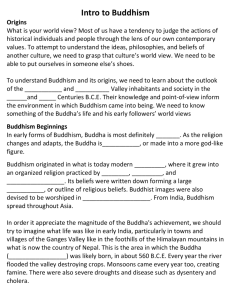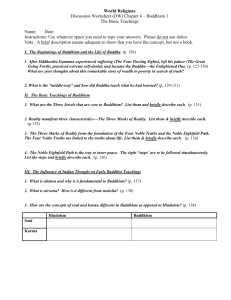Buddhism - University of Mount Union
advertisement

Buddhism Siddhartha http://www.dakiniunlimited.com/images/birth_siddhartha.jpg The Four Passing Sights Prophecy Fulfilled 1. An old man 2. A sick man who was diseased ridden 3. a corpse on the way to being cremated 4. a holy man who had no possessions but was at peace http://images.google.com/imgres?imgurl=http://www.frankossen.com/Old_Man_from_Hampi__India.jpg&imgrefurl=http://www.frankossen.com/Portraits-2.htm&h=529&w=352&sz=24&tbnid=iWAemuvxI8J:&tbnh=129&tbnw=85&hl=en&start=2&prev=/images%3Fq%3Dold%2Bman%2Bindia%26svnum%3D10%26hl%3D en%26lr%3D%26sa%3DG – slide 3 http://i.a.cnn.net/cnn/2004/WORLD/asiapcf/11/23/india.aids.bollywood/tz.sick.man.afp.jpg - slide 3 http://members.chello.se/harryperonius/dod/indien/dead_head.jpg - slide 4 http://www.kamat.com/kalranga/bhiksha/sadhu02.jpg - slide 4 http://zteecher.com/img/siddhartha.jpg - slide 6 http://www.buddhanet.net/e-learning/depend.htm#Ageing – slide 8 http://www.buddhanet.net/e-learning/depend.htm#Craving – slide 8 http://birminghambuddhistcentre.org.uk/index_files/3js.jpg - slide 17 http://www.shambhalabay.ca/images/bodhisattva.jpg - slide 19 http://www.metta.lk/english/APcakra.jpg - slide 20 http://www.harekrsna.it/karma_e_reincarnazione/immagini/reincarnazione.jpg - slide 21 http://seasiancrafts.com/spiritworld/Images/enlightenment%20mural.JPG – slide 22 http://www.zenandbusiness.com/buddha_nirvana.jpg - 23 http://www.info4india.com/indian-personality/images/ashoka.jpg - slide 26 The Path to the Buddha What was his “Pah” Four Noble Truths Embody the idea that craving is the source of suffering and the cessation from craving releases suffering . Four Noble Truths 1. Duhkha or suffering is everywhere 2. Tanha or craving or desire is the source of suffering 3. Relieving craving ceases suffering--when craving ceases entirely through dispassion, renunciation, and nondependence, then suffering ceases 4. The path leading to cessation of suffering is the Eightfold Path Eight Fold Path Like spokes in a wheel Eight Fold Path The Way to Inner Peace Three Main Goals face life objectively live kindly cultivate inner peace Some Things to Remember The steps or recommendations are not to be practiced sequentially but all together The word “right” might be better translated as “correct” or “complete.” Eight Fold Path 1. Right views 5. Right livelihood 2. Right intention 6. Right effort 3. Right speech 7. Right mindfulness 4. Right action 8. Right concentration Eightfold Path Enunciated 1. Right views or Right understanding I recognize the impermanence of life, the mechanism of desire, and the cause of suffering. 2. Right intention My thoughts and motives are pure, not tainted by my emotions and selfish desire. Eightfold Path Enunciated 3. Right speech I speak honestly and kindly, in positive ways, avoiding lies, exaggeration, harsh words. 4. Right action My actions do not hurt any other being that can feel hurt, including animals; I avoid stealing and sexual conduct that would bring hurt. Eightfold Path Enunciated 5. Right work or livelihood My livelihood (occupation) does no harm. 6. Right effort With moderation, I consistently strive to improve. Eightfold Path Enunciated 7. Right mindfulness I will keep my attention, awareness, and mind focussed on the Four Foundations of Mindfulness: the body is impure, sensations result in suffering, the mind is impermanent and all dharma do not have a substantial self. 8. Right concentration I use the disciplines of meditation (dyana) and focused awareness to contemplate the nature of reality more deeply. The Core of Basic Buddhism The Three Jewels The Buddha Is an ideal whom people should imitate and his image of sitting and meditating with self-control and mindfulness. The Dharma is the sum total of Buddhist teachings about how to view the world and how to live properly. “I take refuge in the Buddha.” “I take refuge in the Dharma.” The Sangha is the community of monks and nuns. “I take refuge in the Sangha.” The Writings The sacred writings of Buddhism are written in both Pali and Sankrit as are the writings in Hinduism and the many offshoots. Pali a language related to Sanskrit Sanskrit is called the Latin of India because of its widespread use. (class references will be using Sanskrit) Bodhisattva Being who is to become fully enlightened (possesses bodhi); especially as applied to Gautama, the future Buddha. More generally, in Mahayana Buddhism the term applies to those who have experience enlightenment (bodhi) but who have taken a special vow to continue being reborn into samsara ["the great runaround"] (rather than entering nirvana) so as to deliver others form their suffering by aiding in the attainment of enlightenment. Dhama (Dhamma) Has many meanings in Buddhist texts, the proper one being determining by context and use. However, some of the meanings are: the teaching of the Buddha; the Truth; The Real; moral law; the right duty; religion. Karma (Kamma) Act, action, deed performed by body, speech, or mind, which, according to the intention it embodies, will have a set consequence experienced in this or future rebirth. Good karma are those things that are positive; bad karma is negative. Mara Killing, death, "Destroyer," "Tempter," the personification of evil or attachment to transient conditioned reality (the Wheel of Life) or to this world as an obstacle to attaining of enlightenment; the god of desire and death. Nirvana "Blowing out, quenching (as of a fire)"; the goal of Buddhism, the extinguishing of passionate attachment or desire (raga) fearful hostility or hatred and anger (dvesa), and confusion of delusion (moha), the primary causes of karma and hence bondage of samsara. It is equal to the Hindu goal of moksa (release). Sangha Buddhist community which consist of four assemblies; monks, nuns, laymen, and laywomen. Relation between Sangha, lay society and government The Sangha depends on government support. However, the government does not control the Sangha. This community is a mutual relationship between the "bhiku" (male and female), lay person and the government. Through the community one earns merit; the bhiku teaches dharma. The Development of Buddhism The Energetic King Ashoka (India circa 250 B.C.E.) Inspection after the battle He becomes so horrified at the carnage that he decides that he converted to the idea of nonviolence. He spread the the principle of nonviolence throughout India as a way of converting people. He built stones which had the principles carved in them. Three Schools of Buddhist Thought Theravada Buddhism Mahayana Buddhism The Big Vehicle Vajrayana Buddhism The Way of the Elders The “Diamond Vehicle” Zen Buddhism Enlightenment through Experience The Two Great Branches of Buddhism Theravada Man as an individual Man on his own in the universe – self effort Key virtue: Wisdom Religion a full time job Ideal: the Arhat Buddha a saint Avoids metaphysics Confines prayer to meditation Conservative Mahayana Man as involved with others Man not alone (salvation by grace) Key virtue: karuna, compassion Religion relevant to life in the world (for the layman as well) Ideal: the Bodhisattva Buddha a savior Elaborates metaphysics Includes ritual Includes petitionary prayer Liberal from Huston Smith Note about the soul and karma Although Buddhist do not really believe in a soul they do maintain that traits and characteristics of a person can recombine in a future life. Therefore, part of the karma process is where a persons personality has recombined in the next life. (note: nevertheless the ideas of karma and rebirth were so much part of the thinking that Buddhism had to accommodate the concepts in their teaching. Some Buddhists Sites Basics More Explanations Mandalas Example 1 Example 2








